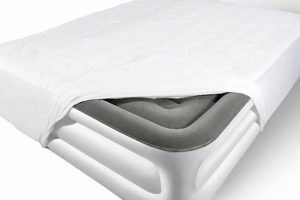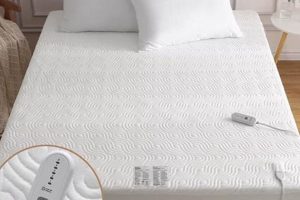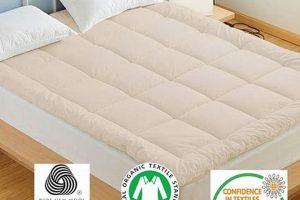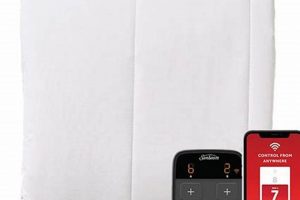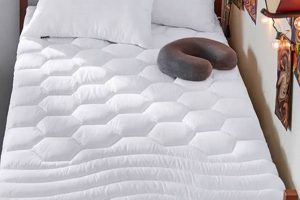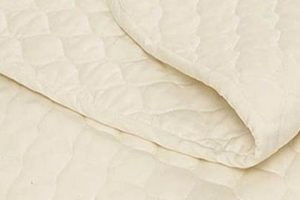A conductive textile designed to be placed on a mattress, connecting the user to the Earth’s electrical potential while sleeping. This typically involves woven silver fibers integrated into the fabric, which then connects to a grounding wire plugged into an electrical outlet’s grounding port. The intent is to facilitate the transfer of electrons from the Earth to the body during sleep.
Proponents suggest several benefits arising from this practice, including improved sleep quality, reduced inflammation, and pain relief. Historically, the practice finds roots in the broader concept of “earthing” or “grounding,” emphasizing direct skin contact with the Earth’s surface for potential health advantages. It’s often presented as a way to mitigate the effects of modern lifestyles that limit exposure to the Earth’s natural electromagnetic field.
The remainder of this article will delve into the materials and construction of these items, discuss the scientific rationale behind the proposed benefits, examine existing research and studies, and provide a balanced perspective on potential advantages and limitations.
Optimizing Usage of a Grounding Mattress Pad
Effective utilization of a grounding mattress pad can maximize potential benefits. The following are points to consider for optimal use.
Tip 1: Ensure Proper Connection: Verify the grounding wire is securely connected to the grounding port of a properly grounded electrical outlet. Testing the outlet with a circuit tester can confirm correct grounding.
Tip 2: Maintain Skin Contact: Maximize skin contact with the pad. Clothing or bedding can act as a barrier, reducing conductivity. Cotton or natural fiber sheets are generally preferable to synthetic materials.
Tip 3: Consistent Use: Regular and consistent use is typically recommended. Benefits may be more noticeable with nightly use over extended periods.
Tip 4: Hygiene Considerations: Follow the manufacturer’s cleaning instructions to maintain the pad’s conductivity and hygiene. Washing methods may vary depending on the materials used.
Tip 5: Monitor for Changes: Observe and document any changes in sleep quality, pain levels, or overall well-being after initiating use. This can help determine its effectiveness for individual needs.
Tip 6: Consider EMF Exposure: Evaluate and, if possible, minimize exposure to electromagnetic fields (EMF) in the sleeping environment. Excessive EMF may interfere with the potential benefits.
Adhering to these guidelines can potentially enhance the experience and effectiveness of a grounding mattress pad.
The following sections will explore the scientific evidence and potential risks associated with the use of grounding devices.
1. Conductive material composition
The effectiveness of a grounding mattress pad is fundamentally dependent on the properties of its conductive materials. These materials serve as the conduit for electron transfer between the user and the Earth, influencing the degree and efficiency of electrical grounding.
- Metal Integration and Conductivity
Silver is frequently incorporated into the fabric of grounding mattress pads due to its high electrical conductivity. The percentage and distribution of silver fibers directly affect the pad’s ability to conduct electrons. Higher silver content generally equates to improved conductivity, facilitating more efficient grounding. For example, a pad with tightly woven silver threads will likely outperform one with sparsely distributed metal.
- Material Blends and Resistance
While metals are crucial for conductivity, other materials are often blended into the fabric for comfort and durability. The type and proportion of these non-conductive materials can influence the overall resistance of the pad. Excessive amounts of insulating materials can impede electron flow, reducing the grounding effect. The optimal blend balances conductivity with comfort and longevity.
- Weave Pattern and Surface Area
The weave pattern of the conductive fabric influences its surface area and contact with the user’s skin. A tightly woven pattern with exposed conductive fibers maximizes skin contact, thereby enhancing electron transfer. Conversely, a loose weave with significant gaps or insulated fibers may reduce the effectiveness of the grounding pad. Therefore, weave pattern selection is critical for the pad’s performance.
- Durability and Longevity
The conductive materials and their integration into the fabric must be durable enough to withstand regular use and washing. Degradation of the conductive elements over time can diminish the pad’s effectiveness. Choosing a pad constructed with high-quality, durable materials ensures a longer lifespan and sustained grounding capabilities. Resistance to oxidation and wear is a key factor in evaluating the long-term performance of a grounding mattress pad.
In conclusion, the type, quantity, and configuration of conductive materials within a grounding mattress pad are paramount to its function. Careful consideration of these factors is essential when evaluating the potential benefits and overall quality of these products.
2. Grounding wire connectivity
The grounding wire connectivity is a critical, integral component in the functionality of a grounding mattress pad. Its proper connection ensures the transfer of electrons between the pad and the Earth’s electrical potential, which is the foundation of the device’s intended effects.
- Grounding Port Integrity
The grounding wire must connect to the grounding port of a three-prong electrical outlet. The integrity of this connection is paramount. A damaged or improperly wired outlet compromises the entire grounding system. Circuit testers can be used to verify the outlet is correctly grounded. If the outlet is not properly grounded, the pad will not function as intended.
- Wire Material and Construction
The material and construction of the grounding wire influence its conductivity and durability. Copper is commonly used due to its high conductivity. The gauge of the wire should be sufficient to ensure minimal resistance to electron flow. A poorly constructed wire with thin gauge or corroded connections can impede grounding, diminishing its effectiveness. Regularly inspecting the wire for damage is advisable.
- Secure Attachment to the Pad
The grounding wire must be securely attached to the grounding mattress pad. A loose or intermittent connection between the wire and the pad fabric interrupts the electron transfer pathway. The attachment point should be designed to withstand regular use and movement without compromising connectivit
y. Periodic checks of the attachment are necessary to ensure consistent grounding. - Length and Placement of the Wire
The length and placement of the grounding wire should be considered to avoid tripping hazards and ensure convenient access to a grounded outlet. Excessively long wires can create safety risks, while wires that are too short may limit placement options. The wire should be positioned to minimize strain on the connection points. Practical considerations regarding wire length and placement contribute to usability and safety.
In summary, the grounding wire connectivity is not merely an accessory but a fundamental element determining the functionality of a grounding mattress pad. Proper attention to the integrity of the grounding port, the wire’s material and construction, the security of its attachment to the pad, and practical considerations regarding its length and placement are all necessary for effective and safe use.
3. Skin contact optimization
Effective grounding through a mattress pad is predicated on direct and consistent skin contact. The human skin’s conductivity facilitates the transfer of electrons, thereby serving as the primary interface for the intended benefits of the device.
- Clothing and Bedding Materials
Intervening layers between the skin and the grounding mattress pad diminish conductivity. Synthetic fabrics, in particular, act as insulators, impeding electron flow. Natural fibers, such as cotton or linen, offer less resistance and are therefore preferable for maximizing skin contact. The type and quantity of clothing worn while sleeping directly impact the effectiveness of the grounding system.
- Body Position and Pressure Distribution
Consistent skin contact is influenced by body position during sleep. Pressure points, where the body makes direct contact with the pad, will exhibit greater electron transfer. Distributing weight evenly across the pad’s surface area maximizes the overall grounding effect. Adjustments to sleeping posture can optimize contact, although this may be limited by individual comfort preferences.
- Moisture and Hydration
Skin hydration levels affect conductivity. Moist skin conducts electricity more effectively than dry skin. Environmental humidity and individual hydration status play a role in skin conductivity. While deliberately increasing moisture is not recommended, maintaining adequate hydration can positively influence electron transfer. Skin dryness may impede grounding, particularly in arid climates.
- Cleanliness and Skin Condition
The presence of oils, lotions, or debris on the skin surface can impede conductivity. Clean skin provides a more direct pathway for electron transfer. Similarly, skin conditions that compromise the epidermal barrier may alter conductivity. Regular cleansing of the skin prior to sleep can optimize contact. However, harsh chemicals should be avoided to prevent irritation.
In conclusion, optimizing skin contact is a controllable variable that significantly impacts the efficacy of a grounding mattress pad. Considerations related to clothing, body position, hydration, and skin cleanliness collectively influence the degree of electron transfer and the potential benefits derived from the device. Addressing these factors enhances the potential effectiveness.
4. Potential health benefits
The theoretical basis for potential health benefits associated with the grounding mattress pad lies in the concept of electron transfer from the Earth to the human body. Proponents suggest that the Earth’s surface possesses a negative electrical charge due to a surplus of electrons, and direct contact allows for the equalization of electrical potential. This equalization, it is argued, may have several physiological effects.
One purported benefit is the reduction of inflammation. Some hypothesize that free radicals, unstable molecules with unpaired electrons, contribute to chronic inflammation. The influx of electrons from the Earth could neutralize these free radicals, potentially mitigating their damaging effects. Another suggested benefit is improved sleep quality. Some users report experiencing deeper and more restful sleep cycles when using a grounding mattress pad. The underlying mechanism may involve the regulation of cortisol, a stress hormone that can disrupt sleep patterns. Limited studies suggest that grounding may help normalize cortisol levels, leading to improved sleep. Pain reduction is also frequently cited as a potential benefit. Chronic pain conditions, such as fibromyalgia, are often associated with inflammation and oxidative stress. The reduction of these factors through grounding may contribute to pain relief.
It is critical to acknowledge that the existing body of scientific evidence supporting these claims is limited and requires further rigorous investigation. While anecdotal reports and small-scale studies suggest potential benefits, larger, well-controlled trials are necessary to establish definitive conclusions. Furthermore, the mechanisms by which grounding may exert its effects remain incompletely understood. While the concept of electron transfer provides a theoretical framework, the precise physiological pathways involved in inflammation reduction, sleep regulation, and pain relief warrant further exploration. The potential health benefits associated with the grounding mattress pad, therefore, remain a subject of ongoing research and should be approached with cautious optimism.
5. Cleaning, care guidelines
The longevity and efficacy of a grounding mattress pad are directly contingent upon adherence to appropriate cleaning and care guidelines. Neglecting these guidelines can compromise the conductive properties of the pad, diminishing its intended benefits, and potentially leading to premature wear and tear.
- Washing Frequency and Method
The frequency and method of washing should align with the manufacturer’s recommendations. Over-washing can degrade the conductive materials, while infrequent washing can allow the accumulation of oils and debris that impede conductivity. Hand-washing or gentle machine cycles with cold water are typically preferred to minimize damage. Harsh detergents and bleach should be avoided as they can corrode the conductive elements.
- Detergent Selection
The selection of detergent is crucial for maintaining the pad’s conductivity. Standard detergents often contain chemicals that leave residues, interfering with electron transfer. Mild, pH-neutral detergents specifically designed for delicate fabrics are generally recommended. Residue-free formulations minimize the buildup of insulating layers on the conductive fibers. Thorough rinsing is essential to remove any remaining detergent traces.
- Drying Procedures
High heat can damage the conductive materials and shrink the fabric of the grounding mattress pad. Air drying is generally the safest method. If machine drying is necessary, a low-heat or no-heat setting should be used. Avoiding dir
ect sunlight exposure during air drying can prevent discoloration and degradation of the fabric. Ensure the pad is completely dry before use to prevent mildew growth and maintain conductivity. - Storage Practices
Proper storage practices are essential for preserving the integrity of the grounding mattress pad when not in use. The pad should be stored in a clean, dry environment away from direct sunlight and extreme temperatures. Folding the pad carefully prevents creases and damage to the conductive fibers. Avoid storing heavy items on top of the pad, as this can compress the fibers and reduce conductivity. Proper storage ensures the pad remains in optimal condition for future use.
In conclusion, conscientious adherence to cleaning and care guidelines is indispensable for maximizing the lifespan and maintaining the effectiveness of a grounding mattress pad. The washing frequency, detergent selection, drying procedures, and storage practices collectively determine the pad’s longevity and its ability to deliver consistent grounding benefits.
Frequently Asked Questions
The following questions address common concerns and misconceptions regarding the use of grounding mattress pads, offering factual information to facilitate informed decision-making.
Question 1: Are grounding mattress pads safe for use with electrical devices and medical implants?
Grounding mattress pads utilize the grounding port of an electrical outlet, which is distinct from the electrical current pathway. The pad itself does not introduce electricity into the body. Individuals with medical implants or those using electrical devices should consult with a healthcare professional prior to use to assess potential interactions and ensure safety.
Question 2: How is the effectiveness of a grounding mattress pad measured?
Directly measuring the effectiveness of a grounding mattress pad in a home setting can be challenging. The most accurate methods involve laboratory testing using specialized equipment to assess conductivity and electron transfer. Subjective assessments of sleep quality, pain levels, and overall well-being are commonly reported by users, but these are not definitive measures of grounding effectiveness.
Question 3: What is the expected lifespan of a grounding mattress pad, and how does washing affect its conductivity?
The lifespan of a grounding mattress pad varies depending on the quality of materials and adherence to care instructions. Proper cleaning, using gentle detergents and avoiding high heat, is crucial for maintaining conductivity. Frequent washing can degrade the conductive fibers over time, potentially reducing the pad’s effectiveness. Follow manufacturer guidelines to maximize the pad’s lifespan.
Question 4: Can a grounding mattress pad eliminate the need for other medical treatments or therapies?
Grounding mattress pads are not intended to replace conventional medical treatments or therapies. They should be considered a complementary approach and not a substitute for professional medical advice. Individuals with health conditions should continue to follow their prescribed treatment plans and consult with a healthcare provider regarding the appropriateness of grounding as a supplementary measure.
Question 5: Is there a risk of electrical shock from using a grounding mattress pad?
When used correctly, a grounding mattress pad poses minimal risk of electrical shock. The grounding wire connects only to the grounding port of an electrical outlet, which is designed to provide a safe pathway for stray electrical currents. Ensure the outlet is properly grounded and the pad is used according to the manufacturer’s instructions to mitigate any potential risk.
Question 6: How does the cost of a grounding mattress pad compare to other sleep-related products, and is it a worthwhile investment?
The cost of a grounding mattress pad varies depending on size, materials, and brand. The cost is comparable to that of premium mattress pads or specialized bedding. Whether it is a worthwhile investment depends on individual needs and expectations. Potential benefits, such as improved sleep or pain relief, should be weighed against the cost and the limited scientific evidence supporting these claims.
Grounding mattress pads may offer some advantages when used correctly, but more research is required to establish definitive conclusions.
The following sections will explore further considerations for the use of grounding products.
Conclusion
This article has explored the “grounding mattress pad,” detailing its construction, proposed benefits, and critical considerations for effective use. The importance of conductive materials, grounding wire connectivity, and skin contact optimization were emphasized. While proponents suggest improvements in sleep quality, inflammation, and pain relief, the current body of scientific evidence remains limited, necessitating further rigorous research to validate these claims.
Ultimately, the decision to incorporate a “grounding mattress pad” into one’s sleep environment warrants careful evaluation of the available evidence and individual needs. Consumers are encouraged to consult with healthcare professionals and conduct thorough research to determine the product’s suitability and potential impact on their overall well-being. The ongoing investigation into grounding’s effects promises to further illuminate its potential role in health and wellness.


